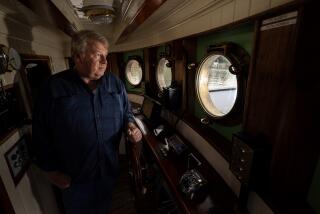STEAMBOATING
- Share via
“Steamboatin’ is like going to visit your grandmother,”
said Capt. Gabe Chengery of the Delta Queen, the last authentic paddle-wheel boat in America to carry overnight passengers.
Listed on the National Register of Historic Places, this 285-foot, four-deck steamboat not only travels almost the entire length of the Mississippi River at a steady 8 m.p.h., but also carries you back in time, re-creating a way of life that captured America’s heart for more than 175 years.
It’s all part of the Delta Queen’s Southern Celebration cruises.
We started in New Orleans on a seven-day trip to Vicksburg, Miss., during what is known as the Spring Pilgrimage. To be held this year from March 12 to April 10, the Spring Pilgrimage features shore excursions from the Delta Queen to plantations, homes and gardens in St. Francisville, La., and the Mississippi towns of Natchez and Vicksburg.
There, hostesses from garden clubs dressed in hoop-skirted gowns share their knowledge of antebellum traditions and treasures.
The Delta Queen makes a grand first impression, with plush green carpet, teakwood handrails, Tiffany stained-glass windows, brass fittings and the sweeping staircase of the main salon.
In their heyday, from 1812 to 1842, more than 4,000 paddle-wheel and keelboats plied the Mississippi, Ohio and Missouri rivers (until cotton got to market faster and cheaper by railroad and eventually by tugboat barges).
Boys who dreamed of escaping the drudgery of farm life aspired to the independent life of a steamboat pilot. Called “floating palaces,” steamboats offered the most magnificent life style that most people of that time had ever seen.
“We provide a safety valve to your hectic modern life styles,” Capt. Chengery said as he circulated among the passengers. “Let your minds breathe and allow yourselves to be pampered. You’ll feel like a frontiersman going back in time.”
Although more than half of America’s millionaires once lived along the river banks between New Orleans and Natchez, producing cotton, sugar cane, indigo and tobacco, none of these stately homes is visible from the river today. Its banks have been heightened by a levee system of 4-by-25-foot concrete “mattresses” to prevent flooding.
Our first visual treat was passing Baton Rouge, La., where ribbons of lights outline America’s tallest city hall and a jigsaw of machinery is visible at the 11-square-mile Exxon oil refinery, the nation’s largest. The smell of gasoline fumes permeated the black sky.
Because the lower Mississippi River is a series of twists and turns, zigs and zags, it took all night to arrive at our first port of call--Houmas House, a Greek Revival plantation an hour’s drive from New Orleans. Highlights of the three-story plantation house include its free-floating spiral staircase, chairs stuffed with Spanish moss, petticoat and courting mirrors, fluting iron, peanut warmer and fly-catcher bowl.
Blasts of music from the 32 gold-plated whistles on the Delta Queen’s calliope signaled our departure.
That afternoon we got acquainted with the boat, learning that it was built in the Isherwood Yard of Glasgow, Scotland, served as a passenger boat in San Francisco, then as a Yard Ferry Boat during World War II.
When the Green Line Steamer Co. paid $46,250 and towed it 5,260 miles through the Panama Canal to New Orleans, the drab Navy-gray paint was replaced with teak, brass and stained-glass elegance. Today the boat is fitted with 90 comfortable, air-conditioned cabins.
teamboat travel on the Mississippi River was dangerous before a government flood-control system was installed. Some boats caught fire or got snagged on driftwood or sand bars. Storms, tornadoes, ice jams and floods were a problem and collisions were frequent, especially on moonless nights. But because of high profits, new boats were quickly built.
With the help of sophisticated government dredging boats to straighten the river, the danger (some say even the romance) has gone out of piloting. Three-mile search beams, fathometers, hydraulic steering, wind indicators and 40-mile radar make the Delta Queen super-safe. But even with smoke detectors, sprinkler systems and fire-retardant paint, special acts of Congress are needed to keep the Delta Queen in service.
After the disaster of the Yarmouth Castle on Nov. 13, 1965, when that Panamanian passenger boat caught fire, burned and sank 60 miles northeast of Nassau in the Bahamas, killing 90 people, all other wooden overnight passenger boats were retired.
All Delta Queen cabins have outside views of the wide Mississippi River, which, during the spring flood tides, immerses shoreline tree trunks in its muddy water. Mark Twain’s words still apply--the river is like “a chocolate tide between solid forested walls . . . a blank watery solitude . . . a majestic unchanging sameness.”
Plenty of activities take place aboard the boat, including games, sing-alongs, lectures and concerts. The happy sounds of New Orleans-style Dixieland music enlivened the Texas Lounge each afternoon. Delicious meals were served on fine china, with lace tablecloths and silver-plate service.
Our next port was St. Francisville on Bayou Sarah to visit the “haunted” Myrtles, a plantation where overnight guests report hearing spirits set loose when a servant poisoned the dessert of the former mistress and her two daughters.
James Audubon painted 80 of his bird pictures in this area. At Rosedown plantation, built in 1834-35 by the Turnbulls, an entrance alley of 200-year-old live oak trees drips with Spanish moss.
Day three was devoted entirely to steamboating--plus kite flying, trivia games, calliope playing, tours of the pilot house and a lecture on 18th-Century ladies’ cotton clothing. Pianist Eric Rosser and banjoist Bud Black entertained.
Capt. Chengery was on hand to describe the life of a river-boat pilot. A butcher’s son, Chengery grew up in a house alongside the Ohio River, where he watched boats at night “lit up like a birthday cake” and heard their calliopes. When on leave in Natchez he plays a calliope in his garage.
At Vicksburg, the farthest point of our 342-mile journey, a multi-image show, “The Vanishing Glory,” gave us a powerful sense of conditions endured during the 47-day Civil War siege when 5,000 residents were forced to live in caves while Union troops bombarded the city around the clock. Gradually weakened by hunger, fatigue and heat, the people surrendered Vicksburg--the key to controlling the Mississippi--on July 4, 1863.
After lunch on the boat we drove the 16-mile one-way road through the National Military Park, where monuments from 26 Civil War states punctuate the wilderness. Of the 17,500 graves, 13,000 are marked as unknown; it is an intensely moving sight.
In downtown Vicksburg the home of diarist Emma Balfour is elegantly restored. The Old Court House shows an extensive collection of antebellum photos, weapons, currency, slave receipts, clothing and furnishings.
Next day was Natchez, the city that Union officers reportedly agreed was “too beautiful to burn.” Many of the 500 antebellum homes that survive offer bed and breakfast to tourists.
ayor Tony Byrne and his wife greeted us at the front door of their home, The Burns. We saw stately Stanton Hall, where the TV miniseries “North and South” was filmed. At Edgewood, breathtaking gardens provided huge bouquets for each palatial room where hostesses in beautiful hoop-skirted gowns described the furnishings.
We had time for an afternoon tour to the Grand Village of the Natchez Indians and to explore part of the Natchez Trace, a 450-mile wilderness highway to Nashville, devoid of commercial traffic and advertising. A national road since 1801, it was pioneered as a path by Ohio Valley farmers who floated produce to Southern markets on keelboats and had no other way to return home but on foot.
Spring Pilgrimage, the highlight of the Natchez social season, is celebrated with a Confederate Pageant of costumed residents forming tableaux from Natchez’s history and presentation of the king and queen. The huge auditorium was filled for the gala evening performance.
On our final day we were greeted in Baton Rouge by guide Henry Le Fleur, dressed in 18th-Century Acadian costume. At a Cajun village on a nearby bayou we met trappers, sampled boudin (sausage), cracklin’ (fried fatback) and spicy shrimps, and watched Cajun folk dances.
Le Fleur gave us a cram course in Louisiana history. He explained how Acadians were separated from their families in Nova Scotia, rejected throughout the East Coast and finally allowed to settle in the mosquito- and alligator-infested Louisiana swampland that no one else wanted.
At our farewell dinner aboard the Delta Queen, the dining room waiters treated us to an uninhibited old-time New Orleans jazz parade. The joint was jumpin’.
Returning to New Orleans and the 20th Century felt more wistful than wonderful. It had been deeply relaxing to slow down for a week and take time to enjoy a special part of our national heritage.
Departure dates for the seven-night Southern Celebration cruises on the legendary Delta Queen are March 7 and 21 and April 1. Prices from $1,036 to $2,674.
Four-night cruises sail March 14 and 28 ($576 to $1,484), and a three-night cruise leaves March 18 ($429 to $1,101). All prices are per person, double occupancy, and all cruises leave from and return to New Orleans, except the April 1 cruise, which ends at Memphis. (The March 28 and April 1 departures are sold out.)
Musicians scheduled to perform are singer Sandra Sidwell, banjoist Black, plus Glenn Wilson and the Riverboat Five.
Another option to consider is the Mississippi Queen, the largest steamboat ever built. It’s not an authentic paddle-wheeler but is more spacious and has more modern conveniences than the Delta Queen. Its Southern Celebration cruises follow the same itinerary, with seven-night cruises departing New Orleans on March 4, 11, 18 and 25 and April 1. Cabins are available for all departures in all categories, from $1,036 to $3,339 per person, double occupancy.
Scheduled performers on the Mississippi Queen cruises are singer Sherri Conner, ragtime pianist Steve Spracklin and banjoist Fred Dodd.
During all Southern Celebration cruises, historians from Louisiana and Mississippi will lecture on various aspects of Victoriana in the South, including architecture, horticulture and general life style. There also will be classes in parlor crafts.
Dress on board the boats is casual, especially on the Delta Queen. During my one-week cruise there were only two occasions for wearing cocktail attire. Also, Delta Queen cabins have limited space for clothing; there was no closet, only a clothes rack.
Each year, 26% of all Delta Queen passengers are from California.
For more information, write to the Delta Queen Steamboat Co., 30 Robin St. Wharf, New Orleans, La. 70130, or call toll-free (800) 543-1949.
More to Read
Sign up for The Wild
We’ll help you find the best places to hike, bike and run, as well as the perfect silent spots for meditation and yoga.
You may occasionally receive promotional content from the Los Angeles Times.






